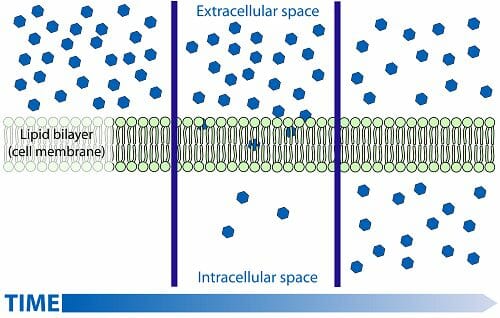Passive Transport Definition
Passive transport, also known as passive diffusion, is a process by which an ion or molecule passes through a cell wall via a concentration gradient, or from an area of high concentration to an area of low concentration. It’s like moving from the train to the platform of a subway station, or stepping out of a crowded room. Basically, passive transport gives an ion or molecule “room to breathe.”
This term is best remembered when juxtaposed with its opposite, active transport. Like physical activity, active transport requires energy. Passive transport, on the other hand, needs no energy at all.
Examples of Passive Transport
Passive transport takes four forms:
- simple diffusion
- facilitated diffusion
- filtration
- osmosis
BAC Goin’ Up
It’s the classic high school health lesson: once ethanol – the “alcohol” ingredient in beer, wine, and spirits – enters your body, it hits your bloodstream at lightning speed. This is why you can have a BAC without feeling drunk, and why some people become thoroughly intoxicated within minutes of taking a shot.
The reason this happens is because ethanol molecules enact simple diffusion, a type of passive transport, with expert ease. Their ultra-microscopic size allows them to pass through cell and tissue membranes without any help, and affect the body without consuming energy.

Neurotransmission Impossible
…well, not quite. The fact that neurons – or brain cells – rely on passive transport to communicate is easy to miss, partly because of how complicated we make them out to be.
Crazily enough, the spindly web of synapses (brain activity) in our head relies on two ions, sodium (Na+) and potassium (K+), which work along a gradient. A neuron in resting potential (not firing) contains a concentration of K+ ions on the inside, and a concentration of Na+ ions on the outside. When the neuron fires (active potential), protein “pumps” on its outer membrane allow Na+ ions to enter the body an K+ ions to exit.
As you can see, Na+ and K+ ions move from an area of high concentration to an area of lower concentration like the ethanol molecules in Example 1. However, they need help to do so. Because they require a little assistance, they perform facilitated diffusion instead of simple diffusion.

(Not) a Pile of Waste
Our intestines do a lot more than push excrement through our bodies. In fact, you could say that extracting nutrients from our food is actually their main job. Although vitamins and minerals tend to be much larger than ethanol and ions, our bodies nonetheless extract them using a form of passive transport.
Filtration, specifically, happens when we separate solids from liquids, and liquids from gasses, via a membrane. Returning to our example, we see that nutrients (liquid) separate from waste (solid) by passing through the intestinal membrane and into the bloodstream.
Fresh Veggies
Soak a raisin in water, and you will get a grape. More than “re-juicing,” soaking raisins constitutes another instance of passive transport – this time, osmosis.
Different from other types of passive transport, it seeks equilibrium rather than simple movement along a concentration gradient. Water passes through the raisin’s membrane not only to reach a less-concentrated interior, but also to make the grape “equal” to its outside environment. This process can happen with other fruits and vegetables, as well, as long as the produce has undergone some form of dehydration.
Related Biology Terms
- Simple diffusion – A process of diffusion that occurs without the aid of an integral membrane protein. Allows substances to pass through cell membranes without any energy.
- Facilitated diffusion – A process that occurs when molecules or ions pass through a cell membrane with the assistance of an integral protein.
- Concentration gradient – The difference in concentration of a dissolved substance in a solution between a region of high density and one of lower density.
- Filtration – The removal of water from solid materials, usually for nutrients to be selectively absorbed into the body.
- Osmosis – The tendency of a fluid to pass through a membrane into a solution where the solvent concentration is higher, thus equalizing the concentrations of materials on either side of the membrane.
- Ion – An electrically-charged atom or group of atoms.
- Molecule – The smallest physical unit of an element or compound, consisting of one or more like atoms in an element and two or more different atoms in a compound.
Quiz
1. In passive transport, ions and molecules move from an area of _______ concentration to an area of ______ concentration.
A. medium, low
B. high, low
C. low, high
D. hard, soft
2. When the large intestine absorbs nutrients, it is performing:
A. filtration
B. active transport
C. osmosis
D. facilitated diffusion
3. Ethanol molecules can perform simple diffusion because:
A. …they don’t care about authority.
B. …they are larger than most membranes.
C. …they are smaller than most membranes.
D. …they’re really smart.
